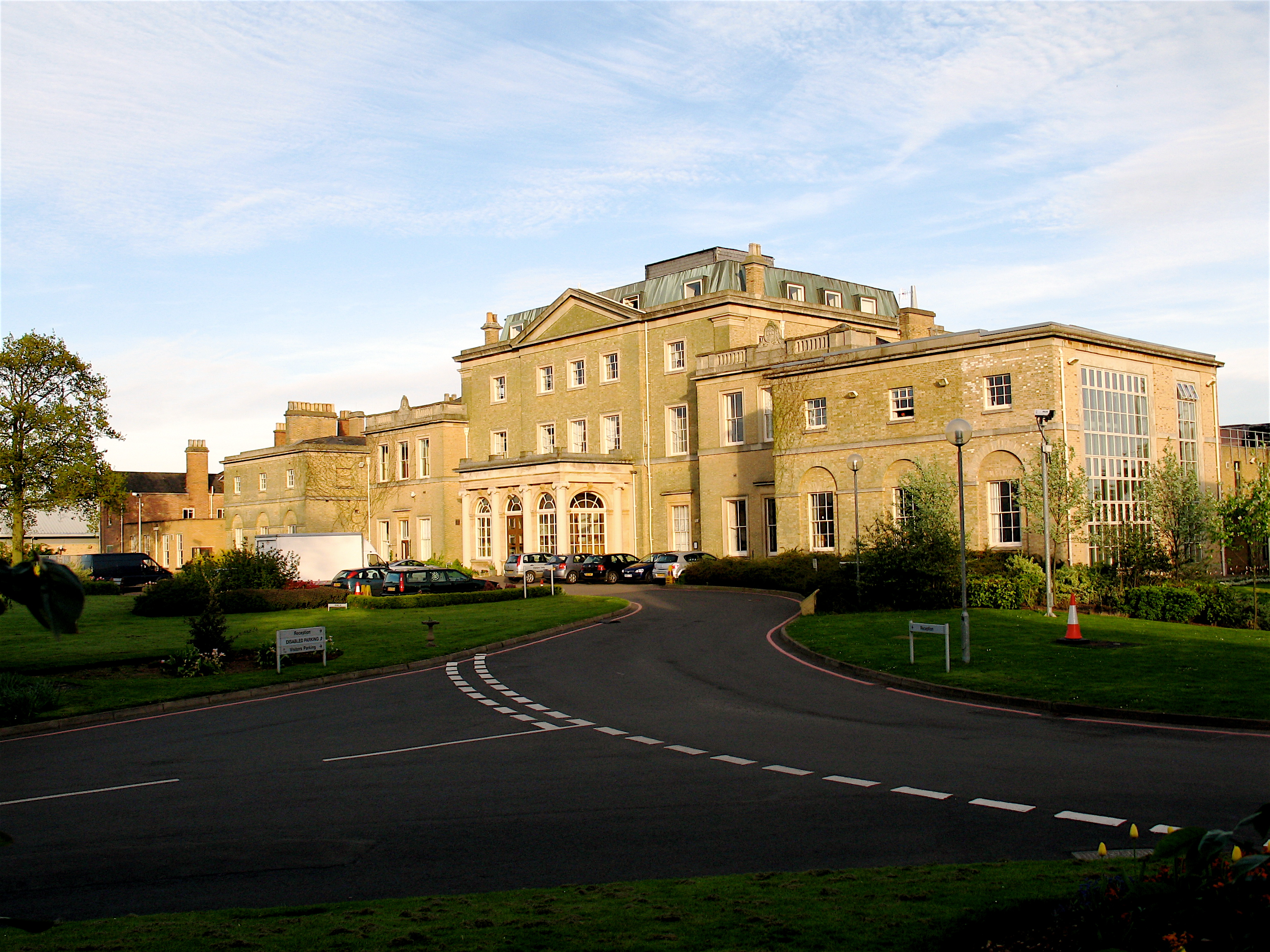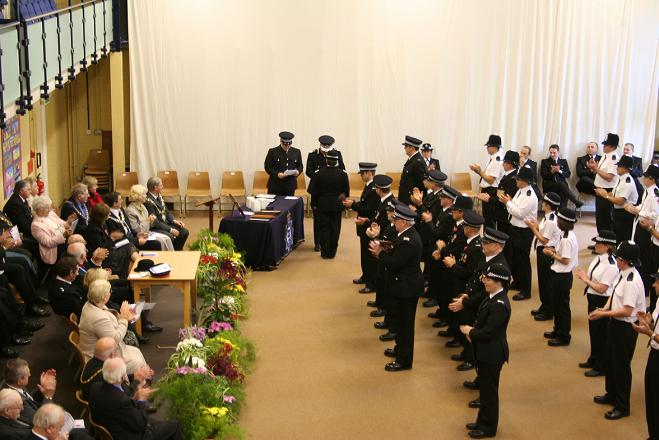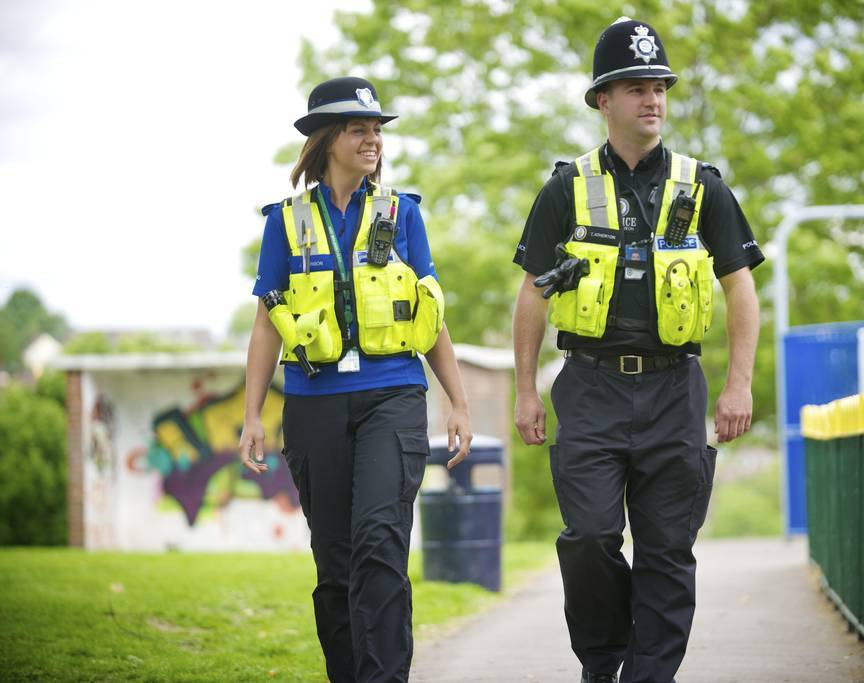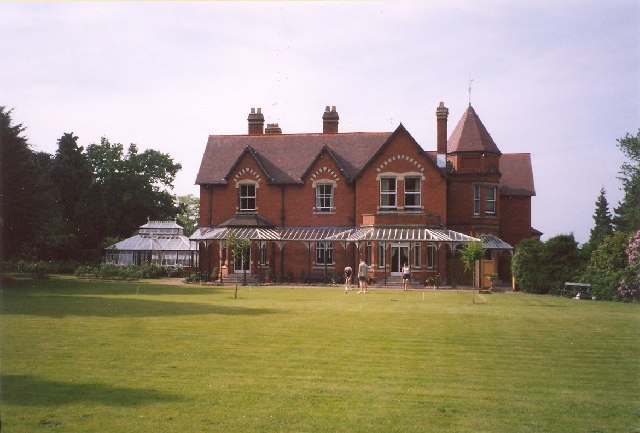|
West Mercia Police
West Mercia Police (), formerly the West Mercia Constabulary, is the territorial police force responsible for policing the counties of Herefordshire, Shropshire (including Telford and Wrekin) and Worcestershire in England. The force area covers making it the fourth largest police area in England and Wales. The resident population of the area is 1.19 million Its name comes from the ancient kingdom of Mercia. The force represents a diverse range of policing environments from densely populated urban areas on the edge of Birmingham as well as Telford, Shrewsbury, and Worcester, to sparsely populated rural areas, such as Herefordshire, which remains an important part of the force's responsibility. As of September 2017, the force has a workforce of 2,017 police officers, 223 police community support officers, 1541 police staff and 388 members of the special constabulary. The force has its headquarters in the historical manor house and grounds of Hindlip Hall on the outskirts of W ... [...More Info...] [...Related Items...] OR: [Wikipedia] [Google] [Baidu] |
Worcestershire Constabulary
Worcestershire Constabulary was the territorial police force responsible for policing rural Worcestershire in central England from 1839 until 1967, when it became part of West Mercia Constabulary. History The Worcestershire Constabulary was formed in 1839, along with borough forces in the towns of Worcester, Evesham, Kidderminster, Dudley, Bewdley and Droitwich. The first headquarters was a three storey house at 15 Britannia Square, Worcester. In 1946 they moved into Hindlip Hall. In 1947 the Worcester Constabulary absorbed Kidderminster Borough Constabulary. On 1 October 1967 the Worcestershire Constabulary was amalgamated with the Shropshire Constabulary, Herefordshire Constabulary and Worcester City Police to form the West Mercia Constabulary, later the West Mercia Police. See also * |
Heraldry
Heraldry is a discipline relating to the design, display and study of armorial bearings (known as armory), as well as related disciplines, such as vexillology, together with the study of ceremony, rank and pedigree. Armory, the best-known branch of heraldry, concerns the design and transmission of the heraldic achievement. The achievement, or armorial bearings usually includes a coat of arms on a shield, helmet and crest, together with any accompanying devices, such as supporters, badges, heraldic banners and mottoes. Although the use of various devices to signify individuals and groups goes back to antiquity, both the form and use of such devices varied widely, as the concept of regular, hereditary designs, constituting the distinguishing feature of heraldry, did not develop until the High Middle Ages. It is often claimed that the use of helmets with face guards during this period made it difficult to recognize one's commanders in the field when large armies gathered together ... [...More Info...] [...Related Items...] OR: [Wikipedia] [Google] [Baidu] |
Special Constabulary
The Special Constabulary is the part-time volunteer section of statutory police forces in the United Kingdom and some Crown dependencies. Its officers are known as special constables. Every United Kingdom territorial police force has a special constabulary except the Police Service of Northern Ireland, which has a Reserve constituted on different grounds. However, the Royal Ulster Constabulary (and the previous Royal Irish Constabulary) did have its own Ulster Special Constabulary from 1920 until 1970, when the Reserve was formed. The British Transport Police (a national "special police force") also has a special constabulary. In the Crown dependencies, the Isle of Man Constabulary and the States of Guernsey Police Service also have special constabularies, but the States of Jersey Police does not. Jersey has Honorary Police. The strength of the special constabulary as of September 2018 in England and Wales was 11,343, -12.3% on the previous year. The number of special const ... [...More Info...] [...Related Items...] OR: [Wikipedia] [Google] [Baidu] |
Police Community Support Officers
A police community support officer (PCSO; cy, swyddog cymorth cymunedol yr heddlu, SCCH), or as written in legislation community support officer (CSO; cy, swyddog cymorth cymunedol, SCC) is a uniformed member of police staff in England and Wales, a role created by Section 38(2) of the Police Reform Act 2002, which was given Royal Assent by Queen Elizabeth II on 24 July 2002. They are non-warranted but provided with a variety of police powers and the power of a constable in various instances by the forty-three territorial police forces in England and Wales and the British Transport Police (which is the only specialist police service to employ PCSOs). PCSOs were introduced in September 2002 and first recruited by the Metropolitan Police. Proposals for PCSOs in Northern Ireland were prevented by a budget shortfall in the Police Service of Northern Ireland, as well as fears that the introduction of uniformed and unarmed PCSOs in Northern Ireland (PSNI constables all carry firear ... [...More Info...] [...Related Items...] OR: [Wikipedia] [Google] [Baidu] |
Worcester, England
Worcester ( ) is a cathedral city in Worcestershire, England, of which it is the county town. It is south-west of Birmingham, north-west of London, north of Gloucester and north-east of Hereford. The population was 103,872 in the 2021 Census. The River Severn flanks the western side of the city centre. It is overlooked by Worcester Cathedral. Worcester is the home of Royal Worcester, Royal Worcester Porcelain, composer Edward Elgar, Lea & Perrins, makers of traditional Worcestershire sauce, the University of Worcester, and ''Berrow's Worcester Journal'', claimed as the world's oldest newspaper. The Battle of Worcester in 1651 was the final battle of the English Civil War, during which Oliver Cromwell's New Model Army defeated Charles II of England, King Charles II's Cavalier, Royalists. History Early history The trade route past Worcester, later part of the Roman roads in Britain, Roman Ryknild Street, dates from Neolithic times. It commanded a ford crossing over the Rive ... [...More Info...] [...Related Items...] OR: [Wikipedia] [Google] [Baidu] |
Shrewsbury
Shrewsbury ( , also ) is a market town, civil parish, and the county town of Shropshire, England, on the River Severn, north-west of London; at the 2021 census, it had a population of 76,782. The town's name can be pronounced as either 'Shrowsbury' or 'Shroosbury', the correct pronunciation being a matter of longstanding debate. The town centre has a largely unspoilt medieval street plan and over 660 listed buildings, including several examples of timber framing from the 15th and 16th centuries. Shrewsbury Castle, a red sandstone fortification, and Shrewsbury Abbey, a former Benedictine monastery, were founded in 1074 and 1083 respectively by the Norman Earl of Shrewsbury, Roger de Montgomery. The town is the birthplace of Charles Darwin and is where he spent 27 years of his life. east of the Welsh border, Shrewsbury serves as the commercial centre for Shropshire and mid-Wales, with a retail output of over £299 million per year and light industry and distribution centre ... [...More Info...] [...Related Items...] OR: [Wikipedia] [Google] [Baidu] |
Telford
Telford () is a town in the borough of Telford and Wrekin and ceremonial county of Shropshire, England, about east of Shrewsbury, south west of Stafford, north west of Wolverhampton and from Birmingham in the same direction. With an estimated population (for the borough) of 175,271 in 2017 and 142,723 in Telford itself, Telford is the largest town in Shropshire and one of the fastest-growing towns in the United Kingdom. It is named after the civil engineer Thomas Telford, who engineered many road, canal and rail projects in Shropshire. The town was put together in the 1960s and 1970s as a new town on previously industrial and agricultural land and towns. Like other planned towns of the era, Telford was created from the merger of other settlements and towns, most notably the towns of Wellington, Oakengates, Madeley and Dawley. Telford Shopping Centre, a modern shopping mall, was constructed at the new town's geographical centre, along with an extensive Town Park. Th ... [...More Info...] [...Related Items...] OR: [Wikipedia] [Google] [Baidu] |
Birmingham
Birmingham ( ) is a city and metropolitan borough in the metropolitan county of West Midlands in England. It is the second-largest city in the United Kingdom with a population of 1.145 million in the city proper, 2.92 million in the West Midlands metropolitan county, and approximately 4.3 million in the wider metropolitan area. It is the largest UK metropolitan area outside of London. Birmingham is known as the second city of the United Kingdom. Located in the West Midlands region of England, approximately from London, Birmingham is considered to be the social, cultural, financial and commercial centre of the Midlands. Distinctively, Birmingham only has small rivers flowing through it, mainly the River Tame and its tributaries River Rea and River Cole – one of the closest main rivers is the Severn, approximately west of the city centre. Historically a market town in Warwickshire in the medieval period, Birmingham grew during the 18th century during the Midla ... [...More Info...] [...Related Items...] OR: [Wikipedia] [Google] [Baidu] |
Mercia
la, Merciorum regnum , conventional_long_name=Kingdom of Mercia , common_name=Mercia , status=Kingdom , status_text=Independent kingdom (527–879)Client state of Wessex () , life_span=527–918 , era=Heptarchy , event_start= , date_start= , year_start=527 , event_end= , date_end= , year_end=918 , event1= , date_event1= , event2= , date_event2= , event3= , date_event3= , event4= , date_event4= , p1=Sub-Roman Britain , flag_p1=Vexilloid of the Roman Empire.svg , border_p1=no , p2=Hwicce , flag_p2= , p3=Kingdom of Lindsey , flag_p3= , p4=Kingdom of Northumbria , flag_p4= , s1=Kingdom of England , flag_s1=Flag of Wessex.svg , border_s1=no , s2= , flag_s2= , image_flag= , image_map=Mercian Supremacy x 4 alt.png , image_map_caption=The Kingdom of Mercia (thick line) and the kingdom's extent during the Mercian Supremacy (green shading) , national_motto= , national_anthem= , common_languages=Old English *Mercian dialect British Latin , currency=Sceat Penny , religion=PaganismChristia ... [...More Info...] [...Related Items...] OR: [Wikipedia] [Google] [Baidu] |
Territorial Police Force
A territorial police force is a police service that is responsible for an area defined by sub-national boundaries, distinguished from other police services which deal with the entire country or a type of crime. In countries organized as federations, police responsible for individual sub-national jurisdictions are typically called state or provincial police. Canada The Royal Canadian Mounted Police (RCMP/GRC) are the federal-level police service. They also act as the provincial police service in every province except for Ontario, and Quebec, who operate provincial police services, as well as Newfoundland and Labrador, which is served by the Royal Newfoundland Constabulary. The RCMP are also contracted to act as the territorial police force in Nunavut, Yukon and the Northwest Territories in addition to being the federal police force in those Canadian territories. Spanish Sahara A separate Sahrawi indigenous unit serving the Spanish colonial government was the ''Policia Territorial' ... [...More Info...] [...Related Items...] OR: [Wikipedia] [Google] [Baidu] |
Oxford English Dictionary
The ''Oxford English Dictionary'' (''OED'') is the first and foundational historical dictionary of the English language, published by Oxford University Press (OUP). It traces the historical development of the English language, providing a comprehensive resource to scholars and academic researchers, as well as describing usage in its many variations throughout the world. Work began on the dictionary in 1857, but it was only in 1884 that it began to be published in unbound fascicles as work continued on the project, under the name of ''A New English Dictionary on Historical Principles; Founded Mainly on the Materials Collected by The Philological Society''. In 1895, the title ''The Oxford English Dictionary'' was first used unofficially on the covers of the series, and in 1928 the full dictionary was republished in 10 bound volumes. In 1933, the title ''The Oxford English Dictionary'' fully replaced the former name in all occurrences in its reprinting as 12 volumes with a one-v ... [...More Info...] [...Related Items...] OR: [Wikipedia] [Google] [Baidu] |








